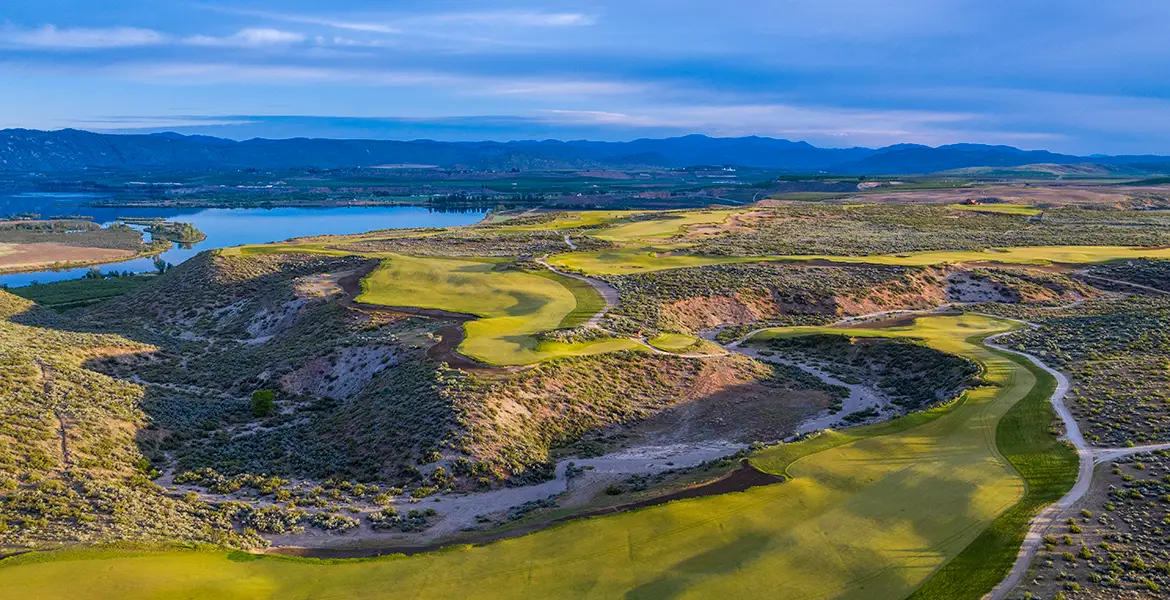In all, 39 championships were played over the last decade and 29 different major champions crowned—equaling a plethora of moments etched in the history of the game.
A total of 29 different golf courses played host to majors over the last 10 years—some much more difficult than others. Which were toughest? And more specifically, which holes were the hardest to play?
With those questions in mind, we blended golf’s four men’s majors and compiled a list of the 10 toughest major championship holes over the last 10 years. Some earned their stripes with statistical data, while others are supported by the formula of intense pressure equaling major carnage.
2020 U.S. Open: Winged Foot Golf Club, 3rd hole
Par three, 243 yards
Winged Foot provided the world’s best with all that they could handle in September 2020. With just a single player finishing the U.S. Open under par (champion Bryson DeChambeau), the 1923 A.W. Tillinghast design showed it has stood the test of time. No hole was more evident of the teeth of Tillinghast than the par-three 3rd, which played the hardest of any hole on the PGA Tour during the 2019–20 season. Stretched out to 247 yards during the final round, it produced an average score of 3.41 with 164 bogeys, 13 double bogeys, and just 22 birdies made on the week. With DeChambeau managing to somehow play the hole at 1-under par for the week (with three pars and one birdie), it’s no wonder he earned his first major title at Winged Foot.
2016 U.S. Open: Oakmont Country Club, 1st hole
Par four, 485 yards
In 2016, Oakmont showed itself to be a complete bear, and the historic club’s first hole wins my “punch in the mouth” award. Golfers at the 116th U.S. Open didn’t even have time to get their feet under them before Oakmont threw them a mean right hook. The hole is long, with bunkers on either side running downhill to a green that slopes away from incoming approach shots. The 1st was the most difficult hole at the 2016 U.S. Open playing to an average score of 4.45. Bogeys were basically pars with 160 of them recorded compared to just 29 birdies on the week. In a common theme, eventual champion Dustin Johnson was one of the few that had success on No. 1, playing the hole at even par for the championship.
2016 Open Championship: Royal Troon, 11th hole
Par four, 482 yards
The Railway hole at Royal Troon plays no favorites. A place where Jack Nicklaus infamously carded a 10 at the 1962 Open Championship, the hole played just as difficult 54-years later. With train tracks hugging the hole and thick gorse looming everywhere you look, the 11th ranked as the most difficult hole on the PGA Tour in 2016. The hole generated 196 scores above par including 26 triple bogeys or worse, playing to an average score of 4.56. Current world No. 1 Dustin Johnson was the most famous and recent victim of the Railway hole, carding a seven in the third round and ending his hopes for the Claret Jug—eventual winner Henrik Stenson played the hole at 2-over par for the week.
2019 PGA Championship: Bethpage Black, 15th hole
Par four, 484 yards
When it comes to major championship venues, not many are as accessible to the recreational golfer as Bethpage Black—the municipal golf course on Long Island that has hosted three majors and two FedEx Cup Playoff events in a two-decade span. The reason? The Black is a heavyweight golf course, with no hole bigger and nastier than the par-four 15th. The hole runs uphill, with a slight left-hand turn to a green set close to 60 feet above the fairway protected by six bunkers waiting to digest approach shots that come up short. The hole was the most difficult at both the 2002 and 2009 U.S. Opens and the 2019 PGA Championship was no different. No. 15 ranked as the second hardest for majors in 2019 with an average score of 4.36 and produced the highest number of bogeys on the entire PGA Tour with 171—19 more than any other hole that season.
2013 U.S. Open: Merion Golf Club, 18th hole
Par four, 521 yards
Heading into the 2013 U.S. Open, some believed that Merion’s championship days had come and gone—that the more than 100-year-old course was simply too short to challenge the game’s elite. Ultimately, that line of thought couldn’t have been more wrong. Merion stood up to the test and was highlighted by its finisher—a 521-yard par four which generated an average score of 4.70 for the week while producing 207 bogeys and 54 double bogeys. The hole did not yield a single birdie in rounds three and four of the ’13 Open and was tied for the toughest hole on the PGA Tour for 2013 with its sister hole, the 5th. Fittingly, the 18th is where the championship was decided, as Phil Mickelson saw his hopes slip away with a bogey while Justin Rose wrapped up his first major title with a par.
2019 Masters: Augusta National, 12th hole
Par three, 155 yards

First things first: No, Golden Bell is not the most difficult hole at Augusta National. And statistically, the par-three 12th is not an overly hard challenge at the Masters. In fact, the hole didn’t crack the top 50 toughest holes on the PGA Tour in 2019. But there are factors in play that can only be explained as the mystique of the Masters, that give this hole the nod. It’s tough to measure pressure, but in 2019 the unpredictability of the Augusta breeze combined with tension of the back nine on Sunday generated epic disaster. Three well established tour pros, two of whom are major champions, saw their Masters dreams disappear into Rae’s Creek—54-hole leader Francesco Molinari, Brooks Koepka, and Tony Finau each recorded double bogeys. Of course, it also paved the way for Tiger Woods’s historic victory as the eventual champion carded four pars on the 12th en route to his fifth green jacket.
2015 Open Championship: St. Andrews, 17th hole
Par four, 495 yards
One of the game’s most iconic holes, “The Road Hole” is also considered by many to be the hardest hole in all of golf—a blind tee shot with a road lining the right side of the fairway and a treacherous pot bunker awaiting errant approach shots. With traditional winds kicking up during the 2015 Open Championship, the 17th lived up to its reputation. The hole was played to an average of .655 strokes over par and garnered 260 scores of bogey or worse, and just nine total birdies (none in the first round). It’s also where Jordan Spieth’s quest for a third consecutive major title came to an end with a bogey on Sunday, leaving him one stroke out of the three-man playoff eventually won by Zach Johnson.
2012 U.S. Open: Olympic Club, 6th hole
Par four, 489 yards

The Lake Course at The Olympic Club was one of the most deceptively difficult major championships sites of the last decade. Despite maxing out at just over 7,100 yards, the club just outside of downtown San Francisco bullied golfers during the 112th U.S. Open. Four of the top 10 most difficult holes of the 2012 major rotation belonged to Olympic, including the par-four 6th which ranked the hardest of them all. The hole played .543 strokes over par during the Open and surrendered just 15 birdies, with a whopping total of 207 scores of bogey or worse. The only player who was able to master the 6th was eventual champion Webb Simpson—his birdie during the final round made him 1-under par on No. 6 for the week and jumpstarted a streak of four birdies over five holes.
2015 U.S. Open: Chambers Bay, 7th hole
Par four, 519 yards
Complaints were more common than birdies at the USGA’s Pacific Northwest experiment in 2015. With a new (and barely tested) golf course baked by unseasonably warm and dry conditions, Chambers Bay was beaten up with criticism. While the golf course took punch after punch, it also hit back with a few of the most brutal par fours on tour. The 7th hole was a monster with a slight dogleg right and forced carry off the tee over a huge bunker complex, leaving golfers with an uphill climb on their approach. A total of 41 scores of double bogey or worse were produced by the hole alone over the week, leading to an average score of 4.48.
2012 Open Championship: Royal Lytham & St. Annes, 3rd and 6th holes
Par fours, 478 & 492 yards

We wrap up this top 10 with a pair of bad boys that flexed their muscle in 2012, during which the 3rd and 6th holes at Royal Lytham & St. Annes proved to be the toughest tandem in golf. No. 6 had played as a par five in previous Open Championships but was changed to a par four to challenge long hitters in 2012. Both par fours played half a stroke over par for the week, conceding just 38 combined birdies and producing 345 bogeys as well as 68 double bogeys or worse. Tiger Woods made a seven on the 6th hole during the final round and both holes had runner up Adam Scott’s number all week long as the Aussie played Nos. 3 and 6 at 3-over par for the tournament. Meanwhile, Ernie Els navigated his way through the two holes at 1-over par and eventually edged Scott by a single stroke to be crowned the 2012 Champion Golfer of the Year.






